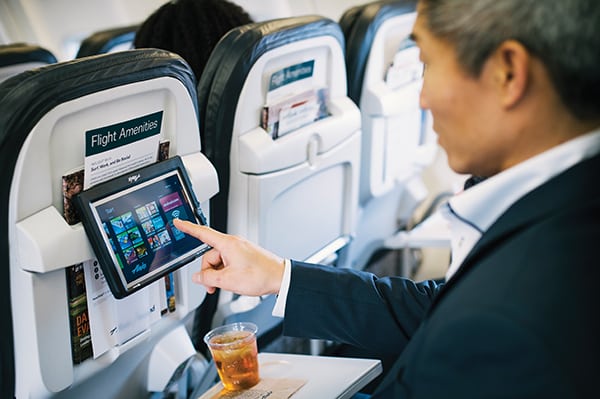
Photo courtesy of Alaska Airlines
Nearly half of all available seat miles worldwide now feature in-flight connectivity, according to a new report. In 2017, 12 new airlines added Wi-Fi to their fleets, and a total of 82 commercial air carriers globally now offer access to web browsing, streaming and other internet-based services.
Data about global airline internet service equipage was released by Routehappy, in a 2018 annual report that has become the commercial aviation’s key source for tracking the pace of aircraft cabin connectivity investment. The annual report from the airline content provider analyzes a combination of available seat miles on flights equipped with Wi-Fi, airline upgrade plans and availability of in-flight connectivity on long-haul versus short-haul routes to assess the global state of in-flight, cabin-based connectivity.
The new report rates aircraft cabin connectivity based on the ability of the in-flight internet service providers’ and manufacturers’ technology to provide streaming in flight. The “best” category describes the antennas, routers, servers and in-flight internet service that provides nearly seamless streaming capability, the “better” category provides little to no streaming, and “basic” aircraft cabin connectivity offers no streaming at all.
Equipage rates show that in-flight streaming on mobile devices is still an elusive capability for most airlines, as only 16% of available flights worldwide provide in-flight internet service capable of streaming video. While that may seem like a low number, it is still a dramatic increase over the statistics reported in Routehappy’s 2017 Wi-Fi report.
“The 129% growth of ‘best’ Wi-Fi is extraordinary,” said Robert Albert, CEO of Routehappy.
One notable trend published in the report is the number of smaller airlines that started offering internet connectivity in 2017, including Air Astana from Kazakhstan, Air Côte d’Ivoire from Ivory Coast and Air Mauritius from the Indian Ocean island of Mauritius.
In recent interviews with smaller U.S.-based carriers such as Sun Country and Allegiant Air, Avionics has discovered differences in opinions from airline executives on whether they feel the need to equip cabins with internet connectivity. Even TAP Portugal CCO Trey Urbahn, whose airline offers internet to passengers on international flights, said the economics of providing internet on inter-European flights is not advantageous to the carrier.
Globally, there are 13 airlines that offer internet service on all of their flights that are more than 2,800 miles, approximately six hours or longer, according to the new report.
“The installation and operational cost of Wi-Fi systems has dropped to levels where just about any airline in the world can begin offering the service, something thought to be impossible for smaller airlines just a few years ago. At the same time, many smaller airlines are beginning to renew their fleets, opting to take new aircraft with Wi-Fi directly from the factory,” the report said.
Competition among service providers is also helping to provide air carriers with a range of options that meet the specific needs of the region they fly in, routes they’re flying and usage trends of their passengers. Air-to-ground and satellite-based service providers Gogo, Inmarsat, Iridium, SmartSky Networks, Viasat and Yahsat all announced major progress in moving to their next-generation speedier in-flight internet networks last year.
There’s even been major initiatives transportation regulators have announced to support in-flight internet service. The Telecom Regulatory Authority of India, for example, published its recommendations for sanction of voice, data and video services over both Wi-Fi and mobile services.
In China, the government of Guangzhou City and Bluefocus IFEC Technology are set to jointly establish the “Belt and Road” in-flight internet fund with a capital injection of 10 billion yuan ($1.5 billion).